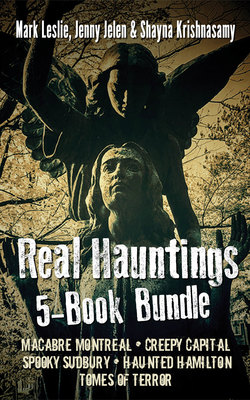Читать книгу Real Hauntings 5-Book Bundle - Mark Leslie - Страница 13
На сайте Литреса книга снята с продажи.
The Murderer’s Cross Concordia University Residence/The Grey Nuns Convent
ОглавлениеHave you seen the large wooden cross on the corner of Guy and René-Lévesque, on the grounds of the former Grey Nuns Convent? At first glance, it seems to be your average Catholic display, with Christ on the cross and religious statues below, surrounded by trees and a garden for quiet worship. The average passerby would hardly give it a second glance. Little do they know that the cross was erected to mark the grave of a murderer buried over 250 years ago.
The Grey Nuns’ former mother house is currently being used as a residence for Concordia University students and has its own haunted history (as described in “Sleeping Above a Cemetery”). But in 1752, the land on which it sits was all farmland and a house sat on the spot where the gates to the mother house are now. The farmer was a man named Jean Baptiste Goyer.
According to the story told by Donovan King, Goyer was a lazy farmer who liked drinking at the tavern better than tending to his crops and as a result, his farm was rundown and he never made very much money. In contrast, his neighbours, the Favres, were good, hard-working farmers who did quite well for themselves.
In May of 1752 Goyer decided to take a trip to Quebec City, a voyage that would take a week’s time. He told a number of people where he was going before locking up his farm and setting off. Upon his return, Goyer was horrified to learn that his neighbours, the Favres, had been brutally murdered in their home, their bodies hacked apart. It was apparently a robbery, as all their money had been taken.
The cross that marks the spot where Jean Baptiste Goyer is buried.
Torn up by the deaths of his closest neighbours, Goyer began to spend more and more time at the tavern. He would talk to anyone who would listen about the “unsolvable” murders, and continually suggested that illegal fur traders were the culprits. Goyer believed that they must have crept in from the woods, murdered the unfortunate family, taken their money, and fled back into the forest, never to be seen again. When he ran out of avid listeners, Goyer would start buying rounds of drinks to keep his captive audience. His money never ran out, and the murders were all he would talk about.
His loose lips and spending habits ended up being his downfall. It wasn’t long before he became the prime suspect in the case, despite his insistence that he’d been out of town at the time. Soon enough he was arrested.
At the time, torture was freely used to obtain confessions from suspects, and a man nicknamed “The Torturer” — Le Bourreau — was brought in to attend to Goyer. Tying Goyer’s hands behind his back, Le Bourreau applied a device called the Spanish boot to the suspect. This instrument consisted of two curved wooden boards, which were tied around the calf in such a way as to resemble a boot. The fit was very snug. Iron spikes or wooden wedges were then hammered between the leg and the boards until the bones of the leg were crushed.
“Did you murder the Favres?” Le Bourreau demanded of Goyer.
“No, I am innocent!” Goyer protested.
But Le Bourreau didn’t believe him. In went the first iron spike.
By the time the third spike was hammered in, Goyer was more than willing to make a full confession through tears of pain: He had not gone to Quebec City as he’d claimed. Instead, he’d hidden inside his house until dark. Then he’d stolen across the fields to his neighbour’s home with his dagger and pistol. He hadn’t meant to murder them, he insisted, only to rob them. But he hadn’t moved quietly enough through the house and Jean Favre had emerged from his bedroom to investigate. Upon spotting Favre, Goyer fired on him with his pistol, a non-lethal shot, and Favre and he began to fight. Grabbing his dagger, Goyer stabbed Favre multiple times until Favre’s body went completely limp. Of course, the noise of such a battle brought Madame Favre out of the bedroom as well, and so Goyer stabbed her, too, and then grabbed a spade and crushed her skull with it for good measure.
There was no question about it — he was sentenced to death. This time the torture wheel was brought out for the purpose. Goyer was tied to the horizontal wheel and as it turned Le Bourreau smashed at his body with a hammer until he was dead. Goyer’s body was tied to a horse-drawn carriage, which dragged him through the streets for a few hours until they arrived at what is now the corner of Guy and René-Lévesque. There they buried him, planting a blood-red cross over his grave. This murderer’s cross was erected at a crossroads, as was the custom, to warn others never to commit the same heinous crime.
Years later, when the roads were widened, the cross was moved to its current location. The spot of Jean Baptiste Goyer’s actual resting place, then, is likely somewhere under René-Lévesque Boulevard, being run over by cars and trucks for all eternity.
